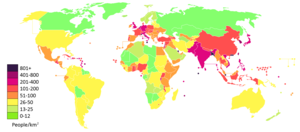Population density: Difference between revisions
m Reverted edits by 67.55.4.94 (talk) to last version by Joshuardavis |
No edit summary |
||
| Line 3: | Line 3: | ||
[[Image:Population density.png|thumb|right|300px|Population density map of the world in 1994.]] |
[[Image:Population density.png|thumb|right|300px|Population density map of the world in 1994.]] |
||
'''Population density''' is a measurement of [[population]] per unit area or unit volume. It is frequently applied to [[living organisms]], [[human]]s in particular. |
'''Population density''' is a measurement of [[population]] per unit area or unit volume. It is frequently applied to [[living organisms]], [[human]]s in particular. and theese lists are only ever compiled by humans, until any ufo claims are substantiated |
||
== Biological population densities == |
== Biological population densities == |
||
Revision as of 22:45, 25 January 2008


Population density is a measurement of population per unit area or unit volume. It is frequently applied to living organisms, humans in particular. and theese lists are only ever compiled by humans, until any ufo claims are substantiated
Biological population densities
Population density is a common biological measurement and is often used by conservationists and measure than population size.
Low densities may cause an extinction vortex and lead to further reduced fertility. This is called the Allee effect, after W. C. Allee who first identified it. Examples of the causes in low population densities include:
- Increased problems with locating mates
- Increased inbreeding
Different species have different expected densities. R-selected species commonly have high population densities, while K-selected species may have lower densities. Low densities may be associated with specialised mate location adaptations such as specialised pollinators; as found in the orchid family (Orchidaceae).
Human population density

For humans, population density is the number of people per unit of area (which may include or exclude cultivated or potentially productive area). Commonly this may be calculated for a county, city, country, another territory, or the entire world.
The world population is 6.6 billion humans, and Earth's area is 510 million square kilometers (200 million square miles). Therefore the world-wide human population density is 6.6 billion / 510 million = 13 per km² (33 per sq mi), or 43 per km² (112 per sq mi) considering that humans live on land, which forms 150 million km² (58 million sq mi) of the earth. This density rises with the population growth. It also includes all continental and island land area, including Antarctica. Since over half of the earth's land mass is desert and high mountains hostile to human habitation, only a fraction of the rest is arable, and population clusters heavily around seaports and fresh water sources, this number by itself significantly understates the level of human crowding.
Several of the highest-density territories in the world are very large city-states, microstates, micronations, or dependencies. These territories share a relatively small area and an exceptionally high urbanization level, with an economically specialized city population drawing also on rural resources outside the area, illustrating the difference between high population density and overpopulation.
Cities with exceptionally high population densities are often considered to be overpopulated, though the extent to which this is the case depends on factors like quality of housing and infrastructure or access to resources. Most of the largest densely-populated cities are in southern and eastern Asia, though Cairo and Lagos in Africa also fall into the category. City population is however, heavily dependent on the definition used for the urban area: densities will be far higher for the central municipality than when more recently-developed and as yet administratively unincorporated suburbs are included, as in the concepts of agglomeration or metropolitan area, the latter including sometimes neighbouring cities.
Other methods of measurement
While the arithmetic density is the most common way of measuring population density, several other methods have been developed which aim to provide a more accurate measure of population density over a specific area.
- Arithmetic density: The total number of people / area of land measured in km² or mi².
- Physiological density: The total population / the amount of arable land.
- Agricultural density: The total rural population / amount of agricultural land.
- Residential density : The number of people living in an urban area / the area of residential land.
- Urban density : The number of people inhabiting an urban area / the total area of urban land
- Ecological optimum: The density of population which can be supported by the area's natural resources.
See also
- List of countries by population density
- List of countries by population
- List of religious populations
- List of U.S. states by population density
- Human geography
- Idealised population
- Optimum population
- Population bottleneck
- Population genetics
- Population health
- Population momentum
- Population pyramid
- Small population size
- Hyperbolic coordinates
External links
- City Ranks combines Google Maps and 2000 Census data to show the population densities of U.S. zip codes on an interactive map.
- Selected Current and Historic City, Ward & Neighborhood Densities
- Population density world-map
